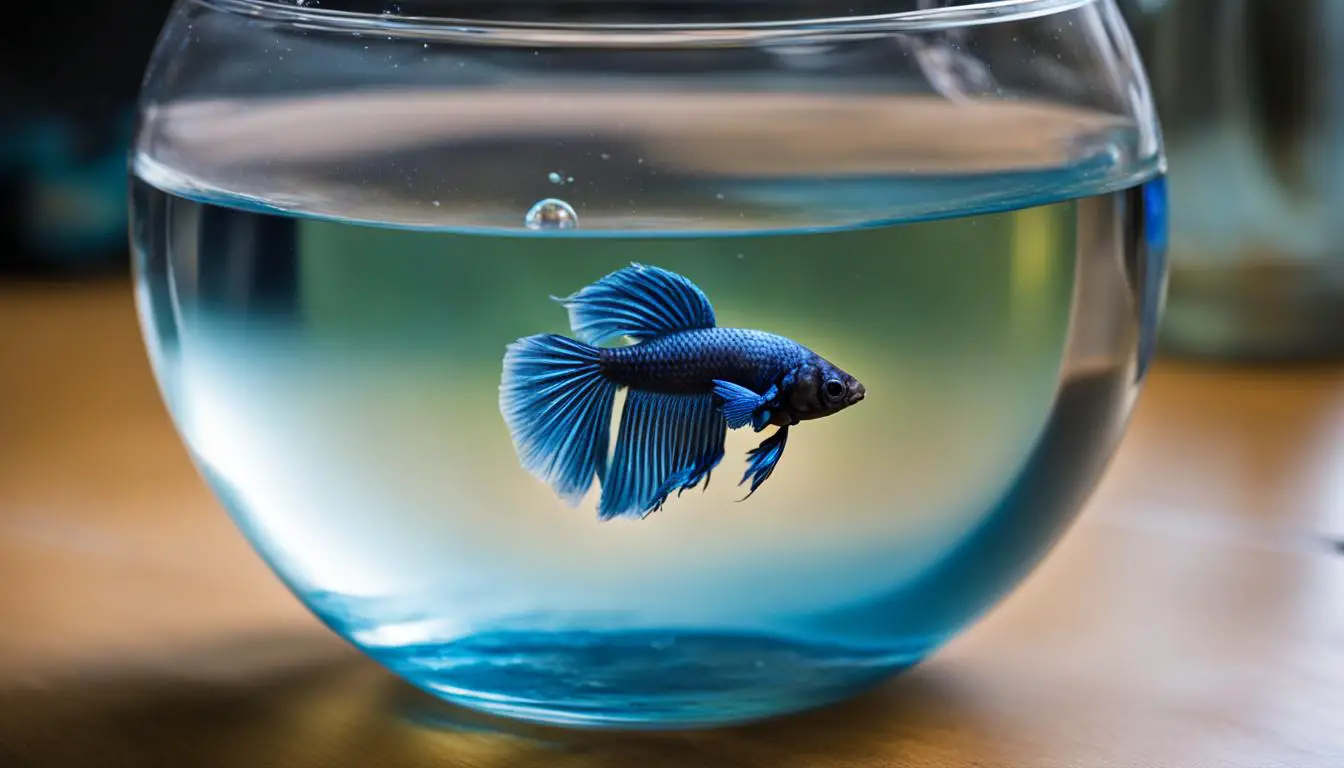Last Updated on 2 years by admin
Betta fish are beautiful, vibrant creatures that require proper care and maintenance to thrive. One critical aspect of betta fish care is treating the water in their habitat. Distilled water may seem like a clean and safe option, but it requires treatment to ensure that it’s suitable for betta fish.
In this comprehensive guide, we’ll take you through the steps of treating distilled water for betta fish. You’ll learn about the importance of maintaining water quality, the potential risks of using distilled water, and the best ways to condition and adjust water parameters. By following these steps, you can ensure that your betta fish live in a safe and healthy environment.
Key Takeaways:
- Distilled water requires treatment before being suitable for betta fish
- Maintaining water quality is crucial for betta fish health
- Cycling the aquarium and testing water parameters regularly are essential steps in betta fish water treatment
- A clean aquarium is necessary for betta fish wellbeing
- Proper acclimation is necessary when introducing betta fish to treated water
Understanding the Importance of Water Treatment for Betta Fish
Treating water for betta fish is crucial for their well-being. In the wild, betta fish live in shallow, warm waters, and they require specific water parameters for optimal health. The water in a betta fish aquarium must be free of harmful chemicals and bacteria to ensure the fish’s safety and good health.
Without proper care, betta fish can suffer from a variety of health issues, including fin rot, fungal infections, and parasites. In severe cases, these conditions can be fatal, leading to the fish’s untimely death.
Betta fish water treatment involves several steps, including conditioning the water with a dechlorinator, adjusting water parameters, and introducing beneficial bacteria to promote a healthy environment. Regular water testing and aquarium maintenance are also crucial to maintaining water quality and ensuring your betta fish’s well-being.
Betta Fish Water Treatment
Maintaining water quality for betta fish requires careful attention to detail and a commitment to proper aquarium care. Betta fish are highly sensitive to changes in water chemistry and temperature, and even small fluctuations can lead to stress and health problems.
Effective betta fish water treatment involves several key steps, including:
- Conditioning the water with a dechlorinator to remove harmful chlorine and chloramines.
- Adjusting water parameters to create a suitable environment for betta fish, including pH levels, temperature, and water hardness.
- Adding beneficial bacteria to promote a healthy biological balance in the aquarium.
- Cycling the aquarium to establish a nitrogen cycle and maintain water quality.
- Testing water parameters regularly to ensure optimal water quality.
- Maintaining a clean aquarium to avoid the buildup of harmful waste and bacteria.
By following these steps and committing to proper betta fish care, you can create a safe and healthy environment for your vibrant betta fish to thrive. Proper water treatment is the key to ensuring your fish’s long-term health and well-being.

The Risks of Using Distilled Water for Betta Fish
While distilled water may seem like a clean and pure option for betta fish, it can actually pose risks to their health. Distilled water is free from minerals, which are essential for betta fish’s health and well-being. Betta fish require minerals to maintain proper osmoregulation, a process that helps regulate the balance of water and minerals in their bodies. Without minerals, betta fish can become stressed and even develop diseases.
Additionally, distilled water has an unstable pH level, which can cause fluctuations in the aquarium’s pH and further stress the fish. The lack of buffering capacity in distilled water can also make it difficult to maintain a stable pH level in the tank.
Another issue with using distilled water is that it lacks essential bacteria that are necessary for a healthy aquarium environment. Beneficial bacteria help break down waste and other organic matter, which can be harmful to betta fish if left untreated. Without these bacteria, betta fish can experience ammonia spikes and other water quality issues.
Overall, using distilled water for betta fish is not recommended. While it might seem like a convenient and straightforward option, the risks it poses to your betta fish’s health outweigh any potential benefits. It’s crucial to treat the water properly before adding it to the aquarium to provide a safe and healthy environment for your betta fish to thrive.
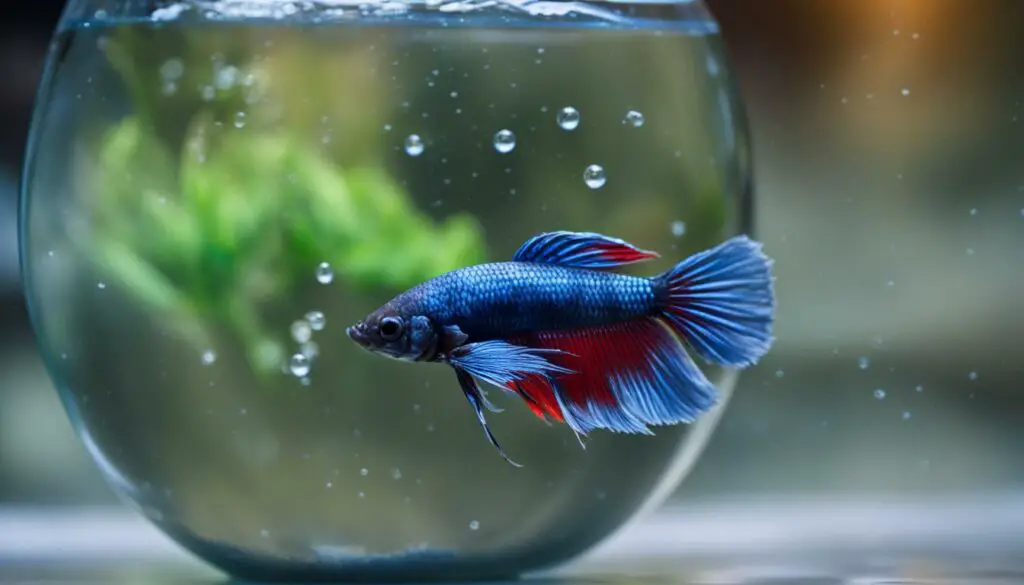
Choosing the Best Water Treatment for Betta Fish
When it comes to selecting the best water treatment for your betta fish, there are several factors to consider. The most important consideration is choosing a product that is specifically designed for betta fish care. Here are some popular options:
| Water Treatment | Description |
|---|---|
| Conditioners | Betta fish water conditioner removes harmful substances such as chlorine and chloramines from tap water and renders it safe for fish to live in. Conditioners often contain essential minerals and vitamins that help improve the health of your betta fish. |
| Reverse Osmosis (RO) Water | Reverse osmosis water (RO) is free from impurities such as minerals and bacteria, providing a blank slate to create an optimal water environment for your betta fish. RO water requires the addition of necessary minerals and nutrients to make it suitable for betta fish habitat. |
| Tap Water | Using tap water for betta fish habitat is possible, but it needs conditioning to remove harmful substances that can be toxic to the fish. Tap water is typically treated with chlorine and chloramines that can harm betta fish, so it is not recommended to use it without proper treatment. |
The best water treatment for your betta fish depends on the unique needs of your aquarium. Consider the type of water source available to you, and the existing water quality to determine the best water treatment options. Remember, while distilled water is pure, it lacks the essential minerals your betta fish need to thrive.
Whichever water treatment option you choose, make sure to follow the manufacturer’s instructions carefully to avoid accidentally poisoning your betta fish. Ensure to use the right dosage, water temperature, and exposure time to maintain water quality and ensure a healthy environment for your betta fish.

Conditioning the Water with a Dechlorinator
If you’re using distilled water for your betta fish, you’ll need to remove harmful chlorine and chloramines before adding it to the tank. The best way to do this is by using a dechlorinator, which neutralizes these chemicals and makes the water safe for your fish.
When choosing a dechlorinator, look for one that is specifically made for betta fish and follow the instructions carefully. Be sure to add the dechlorinator to the water before adding it to the tank. Let the water sit for at least 15 minutes to allow the dechlorinator to work its magic.
One popular option is the Seachem Prime dechlorinator, which not only removes chlorine and chloramines, but also detoxifies nitrate and nitrite, making it a great all-in-one water treatment solution.
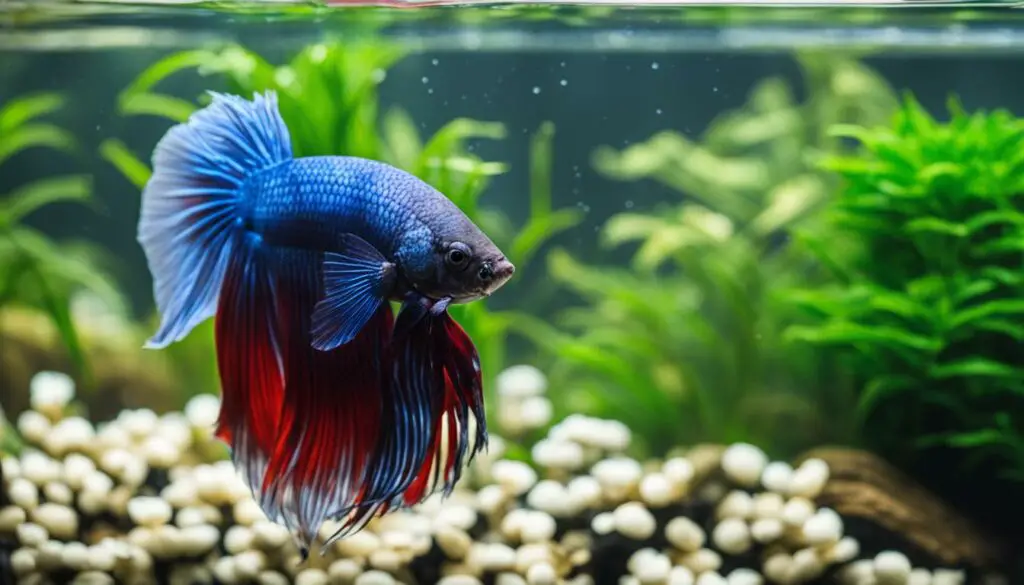
It’s important to note that while dechlorinators are effective in removing harmful chemicals, they do not remove heavy metals or other toxins. Be sure to use high-quality water or a filtration system to ensure the best possible water quality for your betta fish.
Adjusting Water Parameters for Betta Fish
When treating distilled water for betta fish, it’s essential to make sure the water parameters are suitable for your fish. Betta fish are known to prefer slightly acidic water with a pH range between 6.5 and 7.5. The temperature should also be between 76°F and 81°F to mimic their natural habitat.
If your distilled water does not fit these parameters, adjustments must be made. A pH test kit can be used to determine the current pH level of the water. If the pH level is too high or too low, you can use a pH adjuster to bring the water to the desired level. It’s important to follow the instructions carefully and not exceed the recommended dosage.
To adjust the water temperature, a submersible heater can be added to the aquarium. Make sure to choose a heater suitable for your tank size and follow the manufacturer’s instructions for installation and use.
Additional Factors to Consider
Aside from pH levels and temperature, there are other factors to consider when adjusting water parameters for betta fish care. These include:
- Water hardness
- Ammonia, nitrite, and nitrate levels
- Dissolved oxygen levels
- Carbon dioxide levels
A water test kit can help determine these levels and identify any issues that need to be addressed. If necessary, water conditioners or other treatments can be used to correct any imbalances.
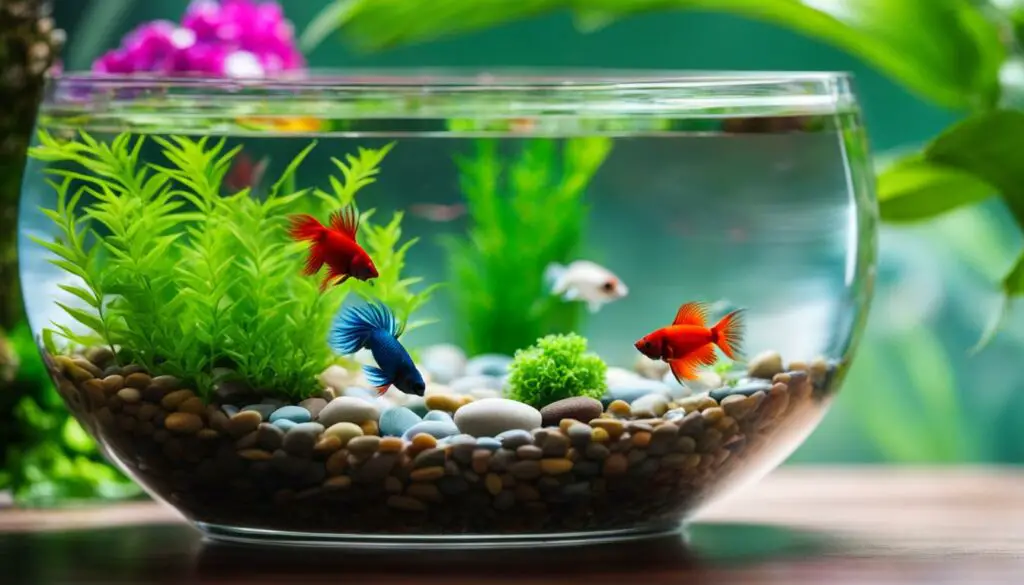
Tip: Before making any adjustments to water parameters, research the specific requirements of your betta fish’s species to ensure optimal care.
Adding Beneficial Bacteria to Promote a Healthy Aquarium
Introducing beneficial bacteria to a betta fish aquarium can help create a healthy biological balance. These bacteria assist in breaking down waste and maintaining good water quality. Beneficial bacteria can also help reduce the risk of diseases and stress in betta fish.
There are two primary methods for introducing beneficial bacteria into an aquarium. The first method is to use live bacteria culture. This culture typically comes in a bottle and can be added directly to the aquarium. You can find live bacteria culture in most pet stores, and they are easy to use. Simply add the recommended amount to the aquarium water, according to the package instructions.
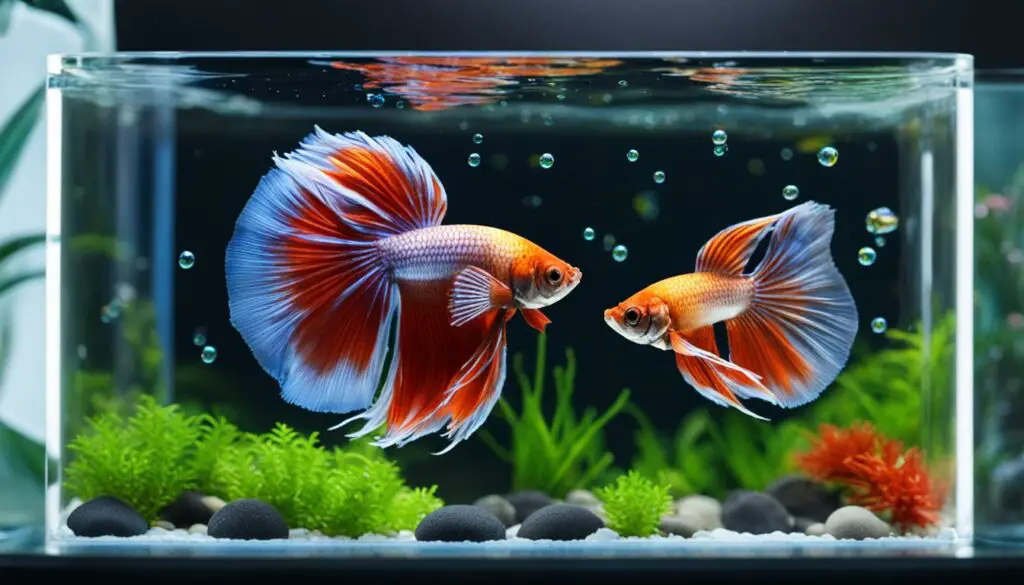
The second method for introducing beneficial bacteria is to use biological media. Biological media typically consists of porous materials, such as ceramic rings or bio-balls, that provide a surface area for bacteria to grow. These media can be placed in the aquarium filter, which allows for a continuous supply of bacteria to be added to the water.
It’s important to note that beneficial bacteria can take several weeks to establish in an aquarium. During this time, it’s essential to monitor water quality closely to ensure proper levels of ammonia and nitrite. You can use a water testing kit to check levels regularly.
Benefits of Beneficial Bacteria
Adding beneficial bacteria to a betta fish aquarium provides several benefits. First, it helps break down waste and reduces the risk of toxic ammonia and nitrite levels. Second, beneficial bacteria help to establish a healthy biological balance in the aquarium, which can help prevent the growth of harmful bacteria and reduce the risk of diseases and stress in betta fish.
Conclusion
Introducing beneficial bacteria to your betta fish aquarium is an essential step in maintaining good water quality and promoting a healthy environment for your fish. By using live bacteria culture or biological media, you can introduce these bacteria into your aquarium and enjoy the benefits of a balanced ecosystem. Remember, it’s essential to monitor water quality regularly and make adjustments as needed to ensure the health and well-being of your betta fish.
Cycling the Aquarium for Better Water Quality
Cycling the aquarium is a crucial step in maintaining water quality for your betta fish. It involves establishing a nitrogen cycle, where beneficial bacteria break down harmful substances in the water and convert them into less harmful forms. This process helps to keep the aquarium clean and healthy for your betta fish.
The nitrogen cycle typically takes four to six weeks to establish, during which time you need to monitor water parameters regularly.
There are three main stages of the nitrogen cycle:
- Ammonia stage
- Nitrite stage
- Nitrate stage
In the first stage, waste produced by your betta fish breaks down into toxic ammonia. In the second stage, bacteria convert the ammonia into nitrite, which is also toxic to fish. Finally, in the third stage, bacteria convert the nitrite into nitrate, which is much less harmful to betta fish in low concentrations.
To establish the nitrogen cycle, you will need to provide a source of ammonia for the beneficial bacteria to feed on. This can be done by adding fish food or pure ammonia to the aquarium.
During the cycling process, it’s important to never change the water completely, as this will remove the beneficial bacteria you’re trying to establish. Instead, perform partial water changes of around 25% to 30% every week.
Once the nitrogen cycle is established, the nitrate levels in your aquarium will begin to rise. To keep them at a safe level for your betta fish, perform regular water changes of around 10% to 25% every week.
Remember to test water parameters regularly to ensure that your betta fish’s environment remains safe and healthy.

Testing Water Parameters Regularly
Maintaining optimal water quality is a crucial aspect of betta fish care. Regularly testing the water parameters in your aquarium can help you identify any changes or imbalances that may be harmful to your betta fish’s health.
There are various water parameters that you should test for, including:
| Parameter | Ideal Range |
|---|---|
| pH Level | 6.5-7.5 |
| Ammonia | 0 ppm |
| Nitrite | 0 ppm |
| Nitrate | <40 ppm |
| Temperature | 75-80°F |
Testing kits are available for each of these parameters and can be purchased at pet stores or online. Follow the instructions on the testing kit carefully to obtain accurate results.
If any parameter is outside of the ideal range, take the necessary steps to correct it. For example, if the pH level is too high or low, adjust it with a pH stabilizer. If the ammonia or nitrite levels are elevated, conduct a partial water change and add a beneficial bacteria supplement.
Regularly monitoring and maintaining proper water parameters is crucial for the overall health and well-being of your betta fish. Make it a habit to test the water at least once a week to ensure a stable and healthy environment for your beloved fish.
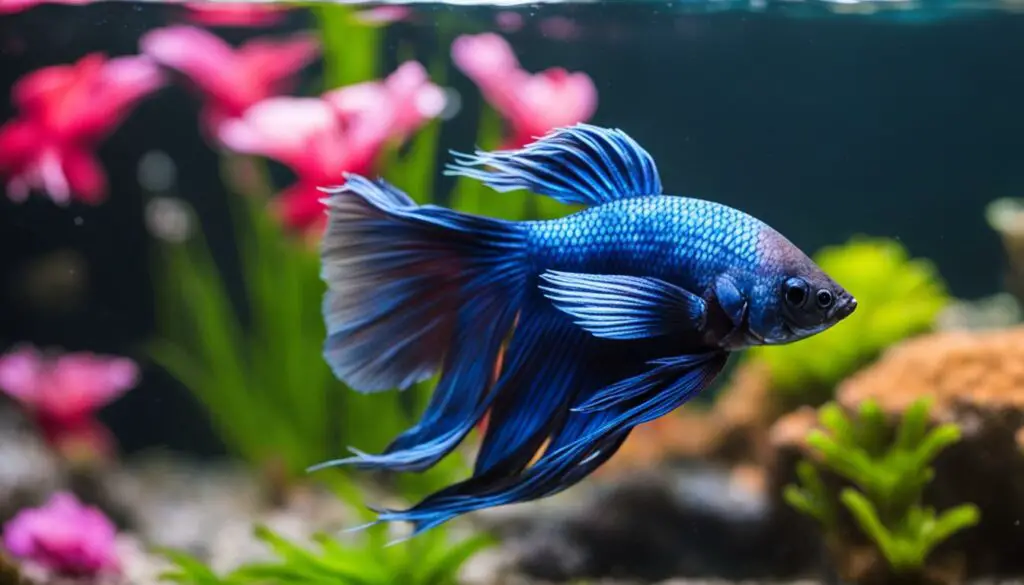
Maintaining a Clean Aquarium
Maintaining a clean aquarium is essential for the health and well-being of your betta fish. A dirty aquarium can lead to poor water quality, which can cause stress, illness, and even death in your fish. Follow these tips to keep your betta fish’s home clean and pristine:
Cleaning Schedule
The frequency of cleaning your aquarium depends on the size of your tank and the number of fish you have. Generally, it’s recommended to clean a small betta fish tank every week and a larger tank every two weeks. Make sure to remove any uneaten food and debris from the bottom of the tank daily, regardless of the tank size.
Cleaning Equipment
When cleaning your aquarium, use a siphon hose to remove water and debris from the bottom of the tank. A small net can be used to remove any floating debris or uneaten food. Be cautious not to disturb the substrate or plants in the tank while cleaning. Use a clean cloth or sponge to wipe the inside of the tank to remove any algae buildup. Avoid using soap or other cleaning agents, as they can be harmful to your betta fish.
Water Changes
Regular water changes are an essential part of maintaining a clean aquarium. Replace approximately 25% of the water in your tank every week. If the water quality is poor, increase the frequency of water changes. When adding new water to the tank, make sure to treat it with the appropriate water conditioner or dechlorinator before adding to the tank.
Decorations and Plants
Decorations and live plants are a beautiful addition to your betta fish’s habitat, but they can also harbor bacteria and debris. Regularly clean and inspect decorations to ensure they are not causing any harm to your betta fish. Check live plants for any signs of disease or decay and remove them immediately if found.

By following these tips, you can maintain a clean and healthy environment for your betta fish. Remember, proper aquarium maintenance is essential for betta fish care and will help keep your fish happy and thriving for years to come.
Introducing Betta Fish to Treated Water
After treating the distilled water for your betta fish, it’s time to introduce them to their new habitat. However, it’s essential to acclimate them gradually to avoid stressing them. Betta fish are sensitive to changes in water conditions, temperature, and pH levels, making it crucial to introduce them slowly to the treated water.
To acclimate your betta fish, there are several steps you can follow:
- Float the bag containing your betta fish in the aquarium for around 15-20 minutes to ensure the water temperature in the bag adjusts to that of the aquarium water.
- Open the bag and add a small amount of aquarium water into the bag every five minutes, without exceeding more than a quarter of the bag’s volume.
- Observe your betta fish for any signs of stress, such as erratic swimming or gasping at the surface of the water. If you notice any stress, pause the acclimation process and wait before resuming.
- Repeat the water addition process until the bag is full with the aquarium water. Then, use a small aquarium net to transfer your betta fish to their new habitat.
After introducing your betta fish to the treated water, monitor them closely for the next few hours. Watch for any signs of stress and ensure they are eating and swimming comfortably. If any issues arise, take appropriate action to rectify the situation.
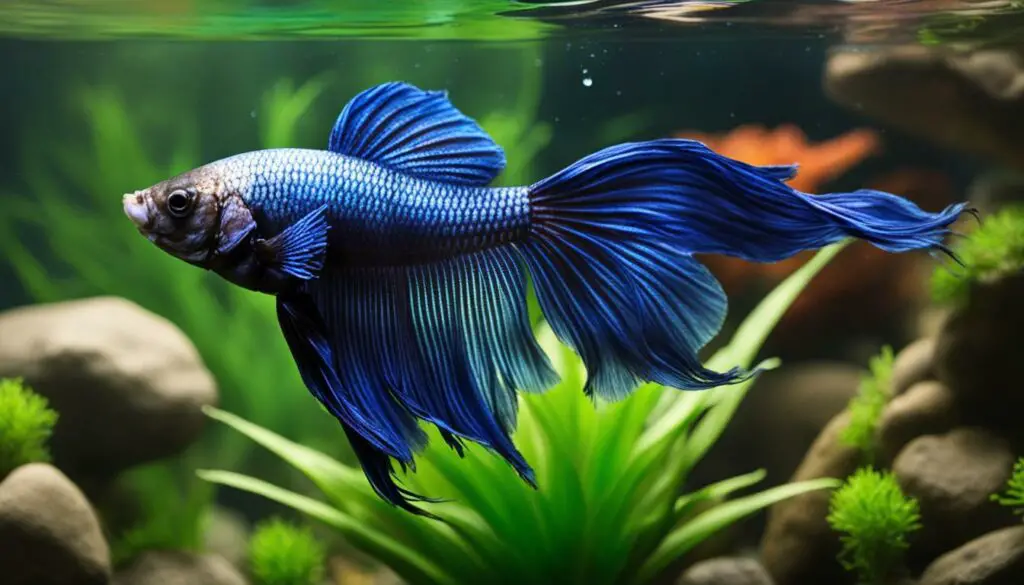
Did You Know? Betta fish are known for their beautiful, striking colors and fins, and are often called Siamese fighting fish because of their aggressive behavior towards others of their kind. However, if kept in a suitable environment and with proper care, betta fish can be peaceful and a joy to watch!
Conclusion
In conclusion, providing proper water treatment for your betta fish is crucial for their health and well-being. By understanding the importance of maintaining water quality and choosing the right treatment method, you can create a suitable environment for your vibrant betta fish to thrive.
Remember to condition your distilled water with a dechlorinator to remove harmful chemicals and adjust water parameters as necessary to meet your betta fish’s specific needs. Additionally, introducing beneficial bacteria and cycling your aquarium can help promote a healthy biological balance.
Regularly testing water parameters and maintaining a clean aquarium are also essential steps in providing optimal care for your betta fish. Finally, when introducing your betta fish to treated water, be sure to follow the proper acclimation process to minimize stress and ensure a smooth transition.
With this easy guide, you can provide your betta fish with the best care possible. Enjoy watching your beautiful fish thrive in their safe and healthy aquatic habitat!
FAQ
Why is water treatment important for betta fish?
Water treatment is crucial for betta fish because it helps maintain water quality and creates a suitable habitat for their health and well-being.
What are the risks of using distilled water for betta fish?
Distilled water can lack essential minerals and nutrients that betta fish need. It is important to treat distilled water before using it to ensure it is safe for your betta fish.
What are the best water treatment options for betta fish?
There are various water treatment options available for betta fish. Some common ones include using a dechlorinator, adjusting water parameters, adding beneficial bacteria, and cycling the aquarium.
How do I condition distilled water with a dechlorinator?
To condition distilled water with a dechlorinator, simply follow the instructions on the product label. Typically, you will add the recommended amount of dechlorinator to the water and let it sit for a specified period before using it in the aquarium.
How do I adjust water parameters for betta fish?
Adjusting water parameters for betta fish involves balancing pH levels, temperature, and other factors. Use appropriate water conditioners and test kits to monitor and adjust these parameters as needed.
Why is adding beneficial bacteria important for my betta fish?
Adding beneficial bacteria helps establish a healthy biological balance in the aquarium. These bacteria break down waste and help prevent harmful ammonia and nitrite buildup, creating a healthier environment for your betta fish.
How do I cycle the aquarium for better water quality?
Cycling the aquarium involves introducing beneficial bacteria and establishing a nitrogen cycle. This process helps convert harmful ammonia into less toxic substances, ensuring better water quality for your betta fish.
How often should I test water parameters?
It is recommended to test water parameters regularly, at least once a week, to ensure optimal water quality for your betta fish. This helps detect any issues early and allows for timely adjustments.
How do I maintain a clean aquarium?
To maintain a clean aquarium, perform regular water changes, remove debris and uneaten food, and clean the tank and filter as needed. Use appropriate tools and products designed for aquarium maintenance.
How do I introduce betta fish to treated water?
When introducing betta fish to treated water, it is important to acclimate them gradually. Float the bag or container with the fish in the aquarium water for about 15-20 minutes to allow them to adjust to the temperature. Then, gently release them into the aquarium.

